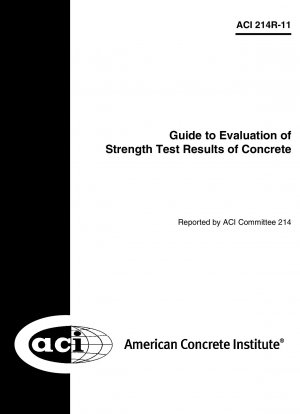ACI 214R-2011
Guide to Evaluation of Strength Test Results of Concrete
- Standard No.
- ACI 214R-2011
- Release Date
- 2011
- Published By
- ACI - American Concrete Institute
- Scope
- Introduction This guide provides an introduction to the evaluation of concrete strength test results. Procedures described are applicable to the compressive strength test results required by ACI 301@ ACI 318@ and similar specifications and codes. Statistical concepts described are applicable for the analysis of other common concrete test results@ including flexural strength@ slump@ air content@ density@ modulus of elasticity@ and other tests used for evaluating concrete and ingredient materials. This guide assumes that the concrete test results conform to a normal distribution. Most construction projects in the United States and Canada require routine sampling of concrete and fabrication of standard molded cylinders. These cylinders are usually cast from a concrete sample taken from the discharge of a truck or a batch of concrete. They are molded and cured following the standard procedures of ASTM C31/C31M and tested as required by ASTM C39/C39M. If the concrete is so prepared@ cured@ and tested@ the results are the compressive strength of the concrete cured under controlled conditions@ not the in-place strength of the concrete within the structure. It is expected that@ given the uniformity of the curing conditions@ these cylinders would have essentially the same strength@ thereby indicating concrete with consistent properties. It is these cylinders that are used for acceptance purposes. Inevitably@ strength test results vary. Variations in the measured strength of concrete originate from two sources: ? Batch-to-batch variations can result from changes to the ingredients or proportions of ingredients@ water-cementitious material ratio (w/cm)@ mixing@ transporting@ placing@ sampling of the batch@ consolidating@ and curing; and ? Within-batch variations@ also called within-test variations@ are primarily due to differences in sampling of the batch sample@ specimen preparation@ curing@ and testing procedures. There are differences in individual mixer batches between the front and rear of the mixer@ as recognized by ASTM C94/C94M. For this reason@ ACI Field Level I Technicians are trained to make composite samples from the central portions of loads. Conclusions regarding concrete compressive strength can be derived from a series of tests. The characteristics of concrete strength can be accurately estimated when an adequate number of tests are conducted in accordance with standard practices and test methods. Statistical procedures provide valuable tools when evaluating strength test results. Information derived from them is also valuable in refining design criteria and specifications. This guide discusses variations in concrete strength and presents statistical procedures useful for interpreting them with respect to specified testing and acceptance criteria. For the statistical procedures described in this guide to be valid@ data should be derived from samples obtained through a random sampling plan. Random sampling is when each volume of concrete has an equal chance of being selected. To ensure this condition@ selection should be made by using an objective mechanism@ such as a table of random numbers. When sample batches are selected on the basis of the sampler's judgment@ biases are likely to be introduced that will invalidate the analysis. Natrella (1963)@ Box et al. (2005)@ and ASTM D3665 discuss the need for random sampling@ and provide a useful short table of random numbers.
